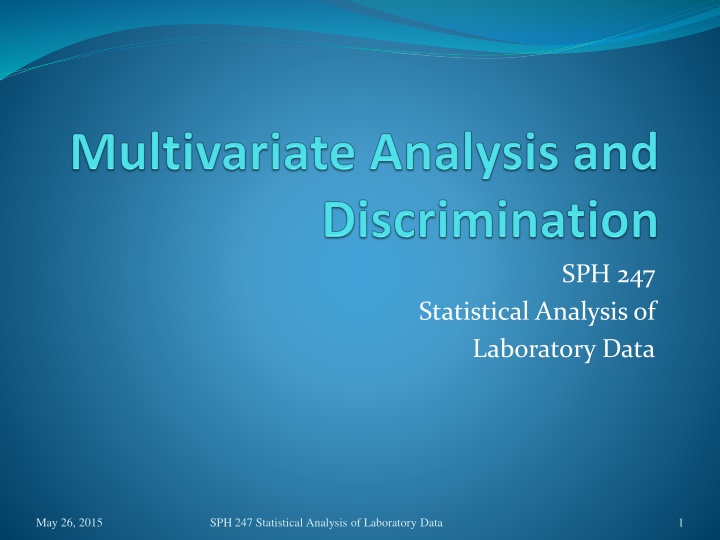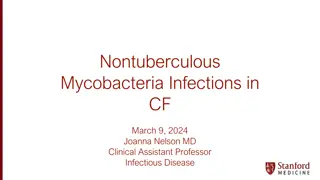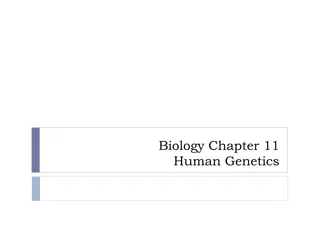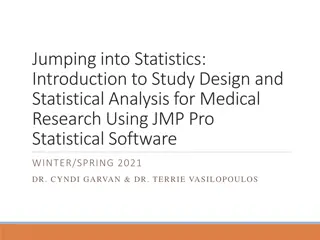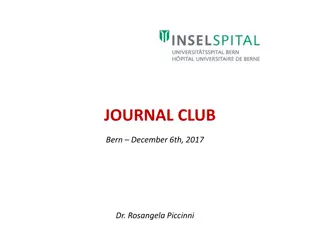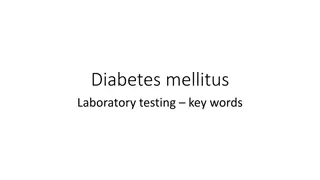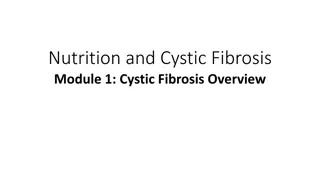Statistical Analysis of Laboratory Data - Cystic Fibrosis Patients
This content focuses on examining the relationships among measures of lung function in cystic fibrosis patients aged 7-23 years old. It includes a data set with variables such as age, sex, height, weight, body mass, forced expiratory volumes, and more. The use of scatterplot matrices and principal components analysis is discussed for exploring these relationships in the data.
Download Presentation

Please find below an Image/Link to download the presentation.
The content on the website is provided AS IS for your information and personal use only. It may not be sold, licensed, or shared on other websites without obtaining consent from the author.If you encounter any issues during the download, it is possible that the publisher has removed the file from their server.
You are allowed to download the files provided on this website for personal or commercial use, subject to the condition that they are used lawfully. All files are the property of their respective owners.
The content on the website is provided AS IS for your information and personal use only. It may not be sold, licensed, or shared on other websites without obtaining consent from the author.
E N D
Presentation Transcript
SPH 247 Statistical Analysis of Laboratory Data May 26, 2015 SPH 247 Statistical Analysis of Laboratory Data 1
Cystic Fibrosis Data Set The 'cystfibr' data frame has 25 rows and 10 columns. It contains lung function data for cystic fibrosis patients (7-23 years old) We will examine the relationships among the various measures of lung function May 26, 2015 SPH 247 Statistical Analysis of Laboratory Data 2
age: a numeric vector. Age in years. sex: a numeric vector code. 0: male, 1:female. height: a numeric vector. Height (cm). weight: a numeric vector. Weight (kg). bmp: a numeric vector. Body mass (% of normal). fev1: a numeric vector. Forced expiratory volume. rv: a numeric vector. Residual volume. frc: a numeric vector. Functional residual capacity. tlc: a numeric vector. Total lung capacity. pemax: a numeric vector. Maximum expiratory pressure. May 26, 2015 SPH 247 Statistical Analysis of Laboratory Data 3
Scatterplot matrices We have five variables and may wish to study the relationships among them We could separately plot the (5)(4)/2 = 10 pairwise scatterplots In R we can use the pairs() function, or the splom() function in the lattice package. > pairs(lungcap) > library(lattice) > splom(lungcap May 26, 2015 SPH 247 Statistical Analysis of Laboratory Data 4
150 250 350 450 80 100 120 140 50 40 fev1 30 20 450 350 rv 250 150 250 200 frc 150 100 140 120 tlc 100 80 180 140 pemax 100 60 20 30 40 50 100 150 200 250 60 100 140 180 May 26, 2015 SPH 247 Statistical Analysis of Laboratory Data 5
May 26, 2015 SPH 247 Statistical Analysis of Laboratory Data 6
Principal Components Analysis The idea of PCA is to create new variables that are combinations of the original ones. If x1, x2, , xp are the original variables, then a component is a1x1 + a2x2+ + apxp We pick the first PC as the linear combination that has the largest variance The second PC is that linear combination orthogonal to the first one that has the largest variance, and so on May 26, 2015 SPH 247 Statistical Analysis of Laboratory Data 7
May 26, 2015 SPH 247 Statistical Analysis of Laboratory Data 8
> lungcap.pca <- prcomp(lungcap,scale=T) > plot(lungcap.pca) > names(lungcap.pca) [1] "sdev" "rotation" "center" "scale" "x" > lungcap.pca$sdev [1] 1.7955824 0.9414877 0.6919822 0.5873377 0.2562806 > lungcap.pca$center fev1 rv frc tlc pemax 34.72 255.20 155.40 114.00 109.12 > lungcap.pca$scale fev1 rv frc tlc pemax 11.19717 86.01696 43.71880 16.96811 33.43691 > plot(lungcap.pca$x[,1:2]) Always use scaling before PCA unless all variables are on the Same scale. This is equivalent to PCA on the correlation matrix instead of the covariance matrix May 26, 2015 SPH 247 Statistical Analysis of Laboratory Data 9
Scree Plot May 26, 2015 SPH 247 Statistical Analysis of Laboratory Data 10
May 26, 2015 SPH 247 Statistical Analysis of Laboratory Data 11
Fishers Iris Data This famous (Fisher's or Anderson's) iris data set gives the measurements in centimeters of the variables sepal length and width and petal length and width, respectively, for 50 flowers from each of 3 species of iris. The species are _Iris setosa_, _versicolor_, and _virginica_. May 26, 2015 SPH 247 Statistical Analysis of Laboratory Data 12
> data(iris) > help(iris) > names(iris) [1] "Sepal.Length" "Sepal.Width" "Petal.Length" "Petal.Width" "Species" > attach(iris) > iris.dat <- iris[,1:4] > splom(iris.dat) > splom(iris.dat,groups=Species) > splom(~ iris.dat | Species) > summary(iris) Sepal.Length Sepal.Width Petal.Length Petal.Width Species Min. :4.300 Min. :2.000 Min. :1.000 Min. :0.100 setosa :50 1st Qu.:5.100 1st Qu.:2.800 1st Qu.:1.600 1st Qu.:0.300 versicolor:50 Median :5.800 Median :3.000 Median :4.350 Median :1.300 virginica :50 Mean :5.843 Mean :3.057 Mean :3.758 Mean :1.199 3rd Qu.:6.400 3rd Qu.:3.300 3rd Qu.:5.100 3rd Qu.:1.800 Max. :7.900 Max. :4.400 Max. :6.900 Max. :2.500 May 26, 2015 SPH 247 Statistical Analysis of Laboratory Data 13
May 26, 2015 SPH 247 Statistical Analysis of Laboratory Data 14
May 26, 2015 SPH 247 Statistical Analysis of Laboratory Data 15
May 26, 2015 SPH 247 Statistical Analysis of Laboratory Data 16
> data(iris) > iris.pc <- prcomp(iris[,1:4],scale=T) > plot(iris.pc$x[,1:2],col=rep(1:3,each=50)) > names(iris.pc) [1] "sdev" "rotation" "center" "scale" "x" > plot(iris.pc) > iris.pc$sdev [1] 1.7083611 0.9560494 0.3830886 0.1439265 > iris.pc$rotation PC1 PC2 PC3 PC4 Sepal.Length 0.5210659 -0.37741762 0.7195664 0.2612863 Sepal.Width -0.2693474 -0.92329566 -0.2443818 -0.1235096 Petal.Length 0.5804131 -0.02449161 -0.1421264 -0.8014492 Petal.Width 0.5648565 -0.06694199 -0.6342727 0.5235971 May 26, 2015 SPH 247 Statistical Analysis of Laboratory Data 17
May 26, 2015 SPH 247 Statistical Analysis of Laboratory Data 18
May 26, 2015 SPH 247 Statistical Analysis of Laboratory Data 19
Discriminant Analysis An alternative to logistic regression for classification is discrimininant analysis This comes in two flavors, (Fisher s) Linear Discriminant Analysis or LDA and (Fisher s) Quadratic Discriminant Analysis or QDA In each case we model the shape of the groups and provide a dividing line/curve May 26, 2015 SPH 247 Statistical Analysis of Laboratory Data 20
One way to describe the way LDA and QDA work is to think of the data as having for each group an elliptical distribution We allocate new cases to the group for which they have the highest likelihoods This provides a linear cut-point if the ellipses are assumed to have the same shape and a quadratic one if they may be different May 26, 2015 SPH 247 Statistical Analysis of Laboratory Data 21
> library(MASS) > iris.lda <- lda(iris[,1:4],iris[,5]) > iris.lda Call: lda(iris[, 1:4], iris[, 5]) Prior probabilities of groups: setosa versicolor virginica 0.3333333 0.3333333 0.3333333 Group means: Sepal.Length Sepal.Width Petal.Length Petal.Width setosa 5.006 3.428 1.462 0.246 versicolor 5.936 2.770 4.260 1.326 virginica 6.588 2.974 5.552 2.026 Coefficients of linear discriminants: LD1 LD2 Sepal.Length 0.8293776 0.02410215 Sepal.Width 1.5344731 2.16452123 Petal.Length -2.2012117 -0.93192121 Petal.Width -2.8104603 2.83918785 Proportion of trace: LD1 LD2 0.9912 0.0088 May 26, 2015 SPH 247 Statistical Analysis of Laboratory Data 22
> plot(iris.lda,col=rep(1:3,each=50)) > iris.pred <- predict(iris.lda) > names(iris.pred) [1] "class" "posterior" "x" > iris.pred$class[71:80] [1] virginica versicolor versicolor versicolor versicolor versicolor versicolor [8] versicolor versicolor versicolor Levels: setosa versicolor virginica > iris.pred$posterior[71:80,] setosa versicolor virginica 71 7.408118e-28 0.2532282 7.467718e-01 72 9.399292e-17 0.9999907 9.345291e-06 73 7.674672e-29 0.8155328 1.844672e-01 74 2.683018e-22 0.9995723 4.277469e-04 75 7.813875e-18 0.9999758 2.421458e-05 76 2.073207e-18 0.9999171 8.290530e-05 77 6.357538e-23 0.9982541 1.745936e-03 78 5.639473e-27 0.6892131 3.107869e-01 79 3.773528e-23 0.9925169 7.483138e-03 80 9.555338e-12 1.0000000 1.910624e-08 > sum(iris.pred$class != iris$Species) [1] 3 This is an error rate of 3/150 = 2% May 26, 2015 SPH 247 Statistical Analysis of Laboratory Data 23
May 26, 2015 SPH 247 Statistical Analysis of Laboratory Data 24
iris.cv <- function(ncv,ntrials) { nwrong <- 0 n <- 0 for (i in 1:ntrials) { test <- sample(150,ncv) test.ir <- data.frame(iris[test,1:4]) train.ir <- data.frame(iris[-test,1:4]) lda.ir <- lda(train.ir,iris[-test,5]) lda.pred <- predict(lda.ir,test.ir) nwrong <- nwrong + sum(lda.pred$class != iris[test,5]) n <- n + ncv } print(paste("total number classified = ",n,sep="")) print(paste("total number wrong = ",nwrong,sep="")) print(paste("percent wrong = ",100*nwrong/n,"%",sep="")) } > iris.cv(10,1000) [1] "total number classified = 10000" [1] "total number wrong = 213" [1] "percent wrong = 2.13%" May 26, 2015 SPH 247 Statistical Analysis of Laboratory Data 25
Lymphoma Data Set Alizadeh et al. Nature (2000) Distinct types of diffuse large B-cell lymphoma identified by gene expression profiling We will analyze a subset of the data consisting of 61 arrays on patients with 45 Diffuse large B-cell lymphoma (DLBCL/DL) 10 Chronic lymphocytic leukaemia (CLL/CL) 6 Follicular leukaemia (FL) May 26, 2015 SPH 247 Statistical Analysis of Laboratory Data 26
Data Available The original Nature paper The expression data in the form of unbackground corrected log ratios. A common reference was always on Cy3 with the sample on Cy5 (array.data.txt and array.data.zip). 9216 by 61 A file with array codes and disease status for each of the 61 arrays, ArrayID.txt May 26, 2015 SPH 247 Statistical Analysis of Laboratory Data 27
Identify Differentially Expressed Genes We will assume that the log ratios are on a reasonable enough scale that we can use them as is For each gene, we can run a one-way ANOVA and find the p-value, obtaining 9,216 of them. We can use apply() or genediff() from LMGene Adjust p-values with p.adjust or padjust Identify genes with small adjusted p-values May 26, 2015 SPH 247 Statistical Analysis of Laboratory Data 28
Develop Classifier Reduce dimension with ANOVA gene selection or with PCA. (We could also use stepwise logistic regression.) Use logistic regression or LDA. Evaluate the four possibilities and their sub- possibilities with cross validation. With 61 arrays one could reasonable omit 10% or 6 at random. May 26, 2015 SPH 247 Statistical Analysis of Laboratory Data 29
Differential Expression We can locate genes that are differentially expressed; that is, genes whose expression differs systematically by the type of lymphoma. To do this, we could use lymphoma type to predict expression, and see when this is statistically significant. For one gene at a time, this is ANOVA. May 26, 2015 SPH 247 Statistical Analysis of Laboratory Data 30
It is almost equivalent to locate genes whose expression can be used to predict lymphoma type, this being the reverse process. If there is significant association in one direction there should logically be significant association in the other This will not be true exactly, but is true approximately We can also easily do the latter analysis using the expression of more than one gene using logistic regression, LDA, and QDA May 26, 2015 SPH 247 Statistical Analysis of Laboratory Data 31
May 26, 2015 SPH 247 Statistical Analysis of Laboratory Data 32
Significant Genes There are 3845 out of 9261 genes that have significant p-values from the ANOVA of less than 0.05, compared to 463 expected by chance There are 2733 genes with FDR adjusted p-values less than 0.05 There are only 184 genes with Bonferroni adjusted p- values less than 0.05 May 26, 2015 SPH 247 Statistical Analysis of Laboratory Data 33
May 26, 2015 SPH 247 Statistical Analysis of Laboratory Data 34
Logistic Regression We will use logistic regression to distinguish DLBCL from CLL and DLBCL from FL We will do this first by choosing the variables with the smallest overall p-values in the ANOVA We will then evaluate the results within sample and by cross validation May 26, 2015 SPH 247 Statistical Analysis of Laboratory Data 35
May 26, 2015 SPH 247 Statistical Analysis of Laboratory Data 36
Within Sample Errors Number of Variables DL/CL Errors DL/FL Errors 1 2 3 4 5 6 7 7 5 0 0 0 4 4 5 3 2 0 May 26, 2015 SPH 247 Statistical Analysis of Laboratory Data 37
Evaluation of performance Within sample evaluation of performance like this is unreliable This is especially true if we are selecting predictors from a very large set One useful yardstick is the performance of random classifiers May 26, 2015 SPH 247 Statistical Analysis of Laboratory Data 38
Number of Variables Percent Errors 24.0% 24.7% 23.3% 24.7% 28.7% 24.7% 26.3% 23.6% 25.7% 24.3% 1 2 3 4 5 6 7 8 9 Left is CV performance of best k variables Random = 25.4% 10 May 26, 2015 SPH 247 Statistical Analysis of Laboratory Data 39
Conclusion Logistic regression on the variables with the smallest p-values does not work very well This cannot be identified by looking at the within sample statistics Cross validation is a requirement to assess performance of classifiers May 26, 2015 SPH 247 Statistical Analysis of Laboratory Data 40
alkfos {ISwR} R Documentation Alkaline phosphatase data Repeated measurements of alkaline phosphatase in a randomized trial of Tamoxifen treatment of breast cancer patients. Format A data frame with 43 observations on the following 8 variables. grp a numeric vector, group code (1=placebo, 2=Tamoxifen). c0 a numeric vector, concentration at baseline. c3 a numeric vector, concentration after 3 months. c6 a numeric vector, concentration after 6 months. c9 a numeric vector, concentration after 9 months. c12 a numeric vector, concentration after 12 months. c18 a numeric vector, concentration after 18 months. c24 a numeric vector, concentration after 24 months. May 26, 2015 SPH 247 Statistical Analysis of Laboratory Data 41
Exercises In the ISwR data set alkfos, do a PCA of the placebo and Tamoxifen groups separately, then together. Plot the first two principal components of the whole group with color coding for the treatment and control subjects. Conduct a linear discriminant analysis of the two groups using the 7 variables. How well can you predict the treatment? Is this the usual kind of analysis you would see? Use logistic regression to predict the group based on the measurements. Compare the in-sample error rates. Use cross-validation with repeated training subsamples of 38/43 and test sets of size 5/43. What can you now conclude about the two methods? May 26, 2015 SPH 247 Statistical Analysis of Laboratory Data 42
